Toyota Proace Max Electric Review 2026
Toyota Proace Max Electric At A Glance
Launched in 2024, the Toyota Proace Max Electric is the Japanese company’s large battery-powered van — a result of its joint LCV venture with Stellantis, the manufacturing group that owns the Citroen, Fiat, Peugeot and Vauxhall brands. So how does it compare to its rivals? Read our full Toyota Proace Max Electric review.
No surprise then that although it's new on the market, the Toyota Proace Max Electric is essentially the same van as the Citroen e-Relay, the Fiat E-Ducato and of course the Peugeot E-Boxer, all of which are EV versions of the the 3.5t large panel van body that was introduced way back in 2006.
Sure, it's been facelifted and improved over the years but is van's fundamental age going to pose Toyota a problem? Perhaps not if buyers are charmed by its qualities, as evidenced by the Vauxhall Movano Electric. It too shares the same basic van design, yet are now common sights on the road despite diesel-engined versions only gaining Vauxhall branding in 2021.
It’s a spacious and competent van but was never originally designed to be electric, of course. The plug-in battery pack and motor having been developed by Stellantis has been shoehorned beneath the body's existing structure.
The replacements for these large vans will have a more integral, multi-brand approach as per the smaller models with Stellantis's marques and Toyota badges but for now the existing model soldiers on, albeit with another extensive revision inside and out.
Also new for this generation of model is the Toyota branding — there are stringent quality criteria that mean that name isn’t given out lightly.
The Toyota Proace Max Electric is powered by an electric motor producing 272PS and 400Nm of torque with a 110kWh battery, meaning it can cover up to 261 miles (WLTP) on a single charge and is equipped as standard with a three-phase 11kW onboard charger.
It can also be charged at 150kW from a DC rapid charger, enabling a 0-80% charge in 55 minutes.
Just one wheelbase is available at 4.04m but with two body lengths available, named L3 and L4, the latter with a larger rear overhang. A chassis cab version is also on sale along with a platform cab for motorhome and minibus conversions.
The panel vans models are offered as standard or high-roof versions, with a maximum load volume of 17 cubic metres.
Visually, the Toyota Proace Max Electric differs from its sister models with a distinctive bumper and grille arrangement but is otherwise little different to the Stellantis models, with full LED headlights and redesigned rear lights.
Inside, there’s a new multifunction steering wheel, dashboard, seat fabrics and door panels, along with a 10-inch touchscreen infotainment system with Apple CarPlay, Android Auto and 3D TomTom Connected Navigation.
Automatic climate control, a wireless phone charger and keyless entry and start provide further comfort and convenience. Additional practicality is provided by an optional 230V socket in the centre of the dashboard for powering electrical devices such as laptops, tablets and other gear up to 150 Watts.
Also of great appeal to small business and SME users, as well as those looking for an electric van to turn into a camper, is Toyota’s class-leading 10-year/120,000 mile warranty.
Driving the Toyota Proace Max Electric
There’s only one battery option on the Toyota Proace Max Electric but it’s a good one.
The 110kWh battery pack feeds a 272PS electric motor giving 410Nm of instant torque, so the van feels lively even when fully laden. It has a WLTP-tested range of 261 miles, which is pretty impressive for a large electric van and this will further boost its appeal to some users.
There are three driving modes: Normal (limited to 218PS power output), Eco for range optimisation (163PS) and Power for full performance (272PS). Whichever mode you’re in, the kick-down function of the throttle will automatically select Power if you’re joining a slip road, for example, so the third setting is largely redundant.
There are also four different levels of regenerative braking, selectable using paddles behind the steering wheel. The most powerful of these will slow the van to walking pace and can feed a fair chunk of boost back to the battery, though it does make for slightly jerky progress until you get used to it.
There are also multiple driver assistance systems including traffic sign recognition, forward collision alert with emergency braking and side blind-spot alert, drowsiness alert, lane keeping assist, adaptive cruise control, 360-degree parking sensors, parking assist and Stellantis’s Dynamic Surround View digital rear view mirror, which projects two camera images from the rear of the van to the driver’s eyeline.
It’s clever stuff but is more useful in dynamic driving rather than for parking and manoeuvring, where the lens curvature of the cameras makes distances deceptive.
The new tech is welcome and on paper makes the Toyota Proace Max Electric look cutting edge but the reality is that it’s still based on an old van and it’s hard to hide the age of the basic vehicle from which it derived — the bouncy ride, overly-firm rear end when unladen and somewhat vague steering mean that the dynamic package can’t match the technological one.
Rivals such as the Mercedes eSprinter are sharper and more modern to drive but if you want a hugely spacious electric van with a decent range and payload, you might not mind that at all.
Toyota Proace Max Electric interior
With a heavy-duty battery and powerful electric motor, the Toyota Proace Max Electric has a commendable payload of 1500kg. That’s still 612kg behind the maximum payload found in the diesel Toyota Proace Max but is nevertheless excellent for an electric van.
It is offered in two lengths and two roof heights, all of which are spacious. Its maximum capacity is 17 cubic metres (L3 H3), while load lengths range from 2.58 metres in medium double cab layout to 4.38m in long wheelbase format.
Inside, the cabin is smart and well-finished, with some excellent features including a folding passenger seat that doubles as a drop-down desk unit, a huge glovebox, document clip and multiple lidded compartments on the dash.
There’s an easy-to-read digital display showing range and battery percentage and a central 10-inch touchscreen covering all major infotainment controls and settings, as well as inductive smartphone charging and sat nav.
In addition, an optional mains socket in the dash can be used to powering items such as laptops and battery chargers, with up to 150W charging requirements. All of these feature disguise the base van's age and give it plenty of user appeal, from a tech perspective at least. Keyless entry and remote start functions are further benefits
Just the one trim level is offered, known as Icon’but it’s well-equipped with electronic climate control, cruise control and the touchscreen as standard.


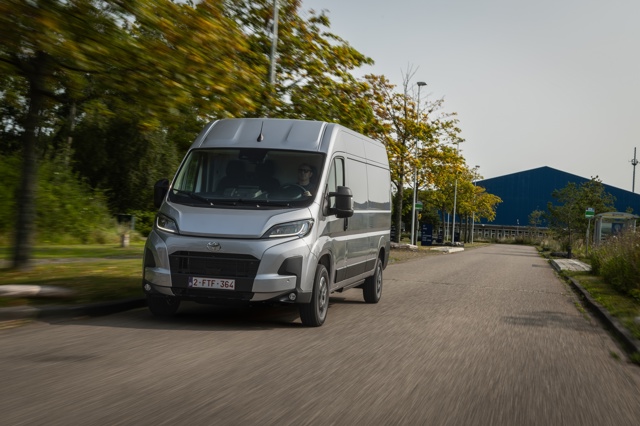
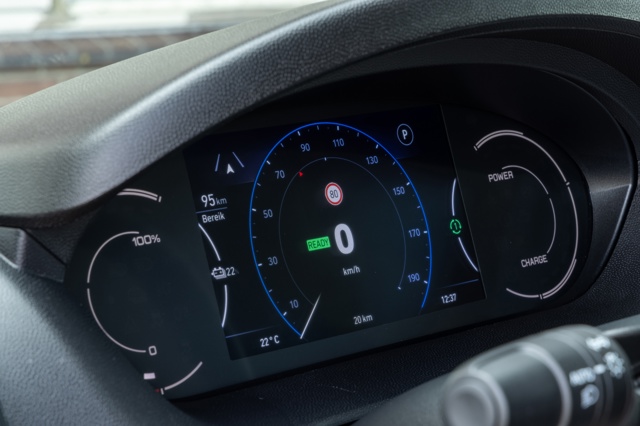
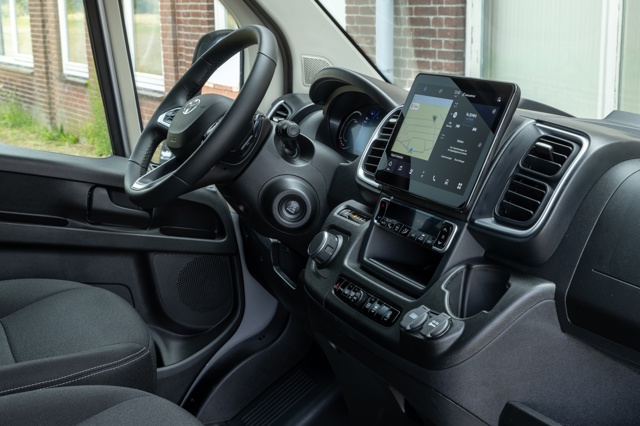
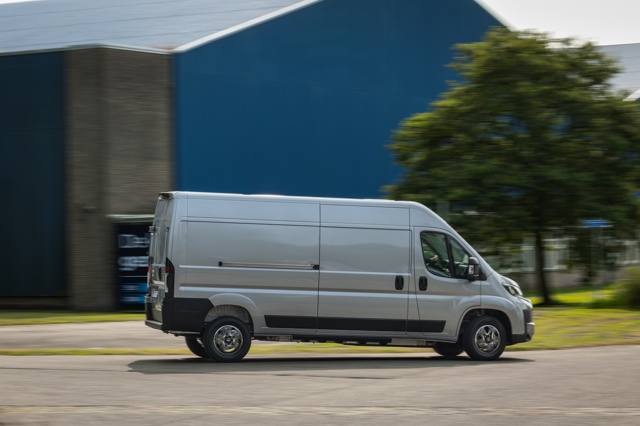
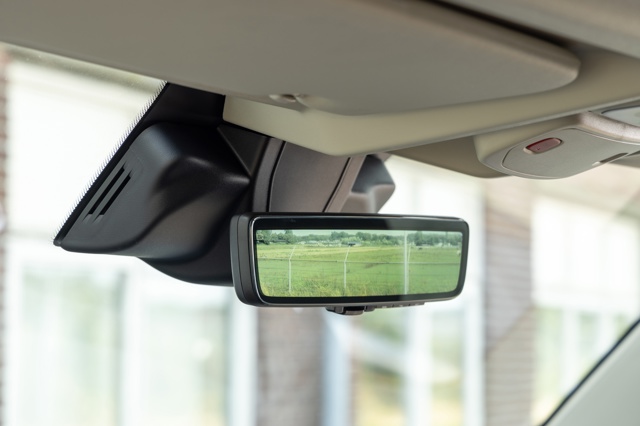
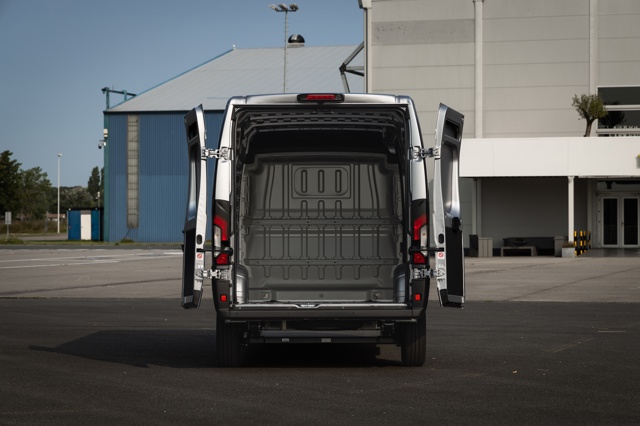
:no_upscale():format(webp)/https://cdn.uk.prod.group-mobility-trader.com/images/cas/a2ea734d3eac6603ce94a1cb82f21419/6e6f5bd28f6a0e5f5bcb2a6bee7cbabd.jpg)

 Spacious, vast load bay, multiple body styles, decent range, refined motor
Spacious, vast load bay, multiple body styles, decent range, refined motor
 Ride and handling, dated styling
Ride and handling, dated styling
:no_upscale():format(webp)/https://cdn.uk.prod.group-mobility-trader.com/images/cas/dca8d5d87aa7f5643a38e37119a7084b/c7af8785dee501c8faf14561eea35f54.jpg)
:no_upscale():format(webp)/https://cdn.uk.prod.group-mobility-trader.com/images/cas/a2ea734d3eac6603ce94a1cb82f21419/6e6f5bd28f6a0e5f5bcb2a6bee7cbabd.jpg)
:no_upscale():format(webp)/https://cdn.uk.prod.group-mobility-trader.com/images/cas/8e5ba37d424d354e22888086c80316de/5bd9196c7c5e9af6c2d0f67409c261e8.jpg)